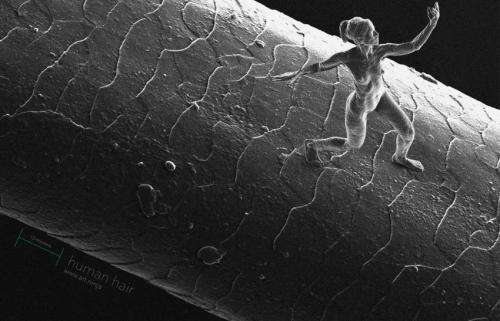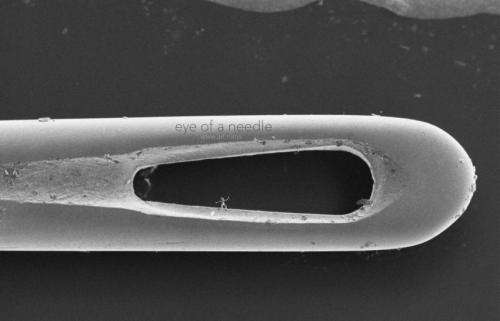November 18, 2014 weblog
When science and art produce nanosculpture marvels

(Phys.org) —Quite a claim: a sculpture as the smallest creation of the human form in history. The sculptor, Jonty Hurwitz, said he loves the Internet. That is because, since the nanosculpture exhibit launch, so many people have viewed his nanosculpture work online and the work has been covered by numerous sites around the world. He created the nanosculptures using a 3D-printed photosensitive material.
Sarah Anderson in 3DPrint.com referred to this as impressive art that we will never see, at least not with the naked eye, as the sculptures are so small. He did a series of seven sculptures. The largest, she said, is about the width of a human hair; the smallest is less than half that width. Hurwitz did not achieve this alone; he recognized this was an effort where art meets science. It was a case of creating art with the use of quantum physics. Hurwitz enlisted a team to work this out. Hurwitz said, "The only way to perceive these works is on the screen of powerful scanning electron microscope. So how can you ever know that this sculpture really exists? Your only way to engage with it is through a screen, and a mouse separating you and the art via a vacuum and a series of mathematically mind-blowing quantum processes that shower the art with particles to map its contours. Can you be sure of its existence if your basic senses are telling you that nothing is there? The line between myth and science is fine."
Multiphoton lithography was the technique used.
"If you illuminate a light-sensitive polymer with Ultra Violet wavelengths, it solidifies wherever it was irradiated in a kind of crude lump. Some of you may have experienced a polymer like this first hand at the dentist when your filling is glued in with a UV light. If however you use longer wavelength intense light, and focus it tightly through a microscope, something wonderful happens: at the focus point, the polymer absorbs TWO PHOTONS and responds as if it had been illuminated by UV light, namely it will solidify. This two photon absorption occurs only at the tiny focal point – basically a tiny 3D pixel (called a Voxel). The sculpture is then moved along fractionally by a computer controlled process and the next pixel is created. Slowly, over hours and hours the entire sculpture is assembled pixel by pixel and layer by layer."
He credits the support he received from experts from the Institute of Microstructure Technology, Karlsruhe Institute of Technology, for fabrication and imaging and advice from Weizmann Institute of Science. "Trust," a piece depicting a female human model, is around 80 x 100 x 20 microns.

Softpedia's Sebastian Pop delivered an account of the creation process and aftermath. A key word about the sculpture was "were," he said, since the lifespan of the sculptures was accidentally cut short, by the man's colleague who made an attempt to see them from a different angle. Hurwitz had spent ten months on seven sculptures; but the images remained.
"He used around 250 cameras to gather all the photos he needed for the subjects of study, all arranged in a dome around the woman, sculpture, etc. Then he spent 10 months designing, sculpting and rendering virtual models, with the help of a high-powered program that reassembled the images into 'digital clay,' wrote Pop. "Finally, the models were ready to be 3D printed."
Had they survived, he remarked, "We'd have liked to see a mirror+microscope installation in a museum exhibit, where visitors would take a peek at the little marvels."
More information: www.jontyhurwitz.com/nano
© 2014 Phys.org



















